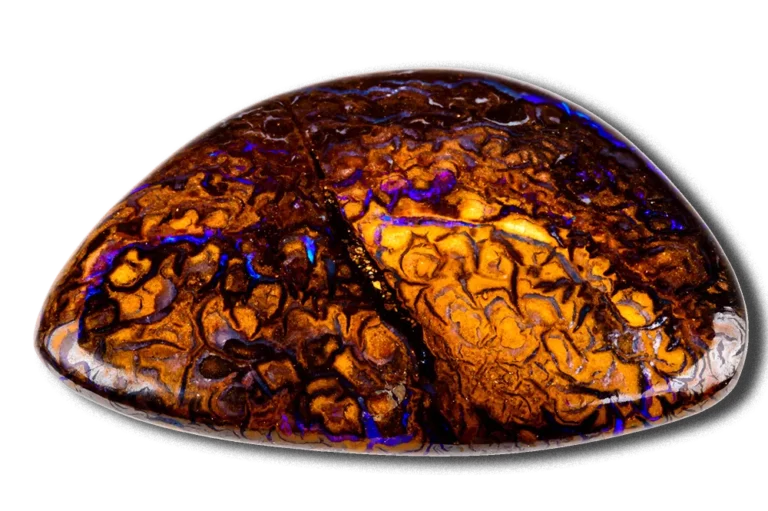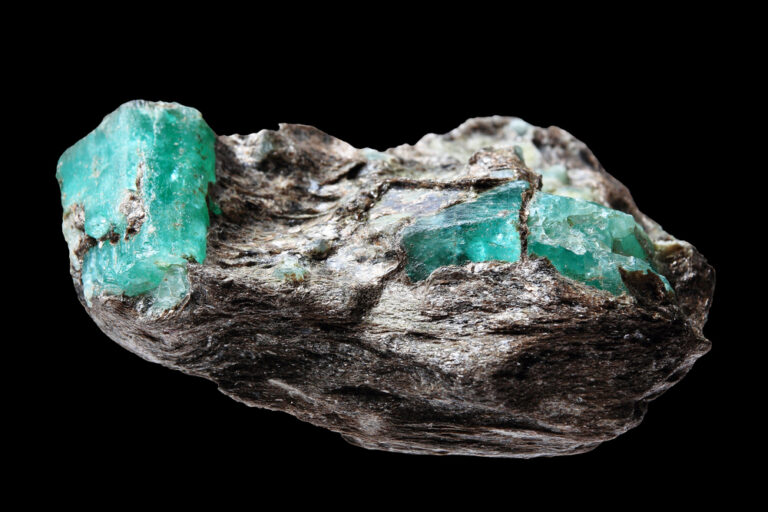Kyanite Crystal: Properties, Benefits & Meanings
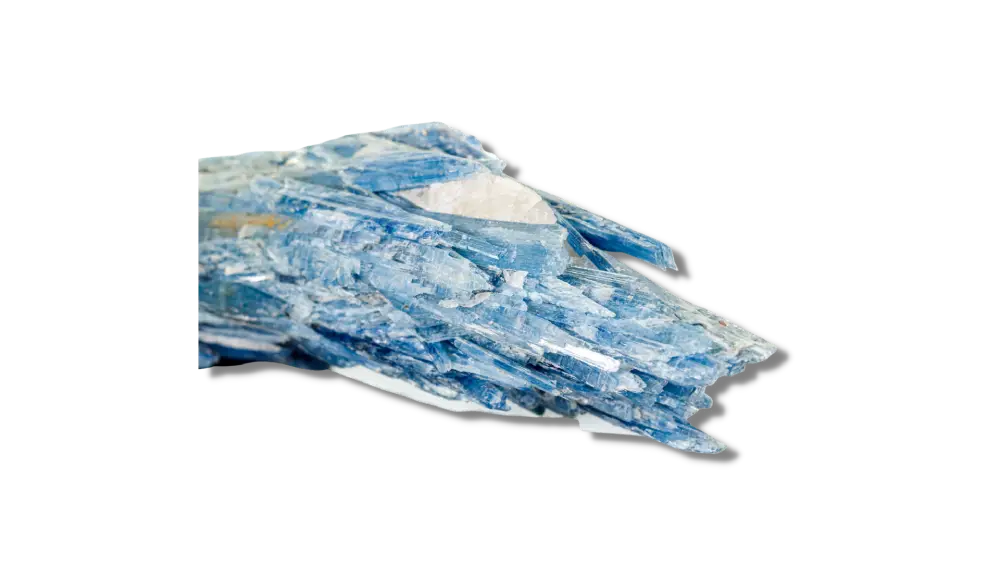
Kyanite Crystal Overview
Kyanite crystal is a stunning crystal that comes in many different colors, but blue is the most common one. This stone also has alternating layers of different minerals giving it a unique and exciting look.
Because of its multiple layers, it is very tough, making it perfect for use in jewelry and other decorative pieces. It is the centerpiece of many gemstone collections due to its different properties and colors.
This article will take a look into the properties, meanings, and uses of Kyanite Crystal.
What Is Kyanite?
Kyanite crystal is a beautiful translucent blue mineral. Since blue is very rare in nature, Kyanite is highly prized by gem collectors. It is known as a symbol of communication and compassion and connects to the third eye chakra.
The blue color of Kyanite comes from impurities in the mineral. The amount in each stone determines its hue, ranging from light blue to dark blue with a hint of green or violet.
Etymology
The name “kyanite” comes from the Greek word for sapphire—kyanos—because of its blue color. The mineral is sometimes called disthene in older publications and texts, after the Greek word for diamond—disthenos—which means “hard.”
Names
Kyanite crystal is known by many other names, such as :
- Disthene
- Cyanite
- Peacock stone
- Fairy stone
Discovery
Kyanite crystal was first found in 1789 and named by Abraham Gottlob Werner, who thought it was related to the mineral cassiterite (which is tin oxide).
Abraham Gottlob Werner was a German mineralogist who studied Kyanite in the late 18th and early 19th centuries. He published his findings on Kyanite in 1815 and is considered the first person to explore this mineral in depth.
Werner’s work influenced many other mineralogists, including his son, Friedrich August von Werner. The Werner name is still well-known today due to its extensive work identifying and classifying minerals.
Kyanite Crystal Appearance
Kyanite crystal is a beautiful blue-green mineral, notable for its fibrous structure and smooth, shimmery appearance. It can be found in many colors, but the most popular is an intense blue-green.
Kyanite has a hardness of 4- 7.5 on the Mohs scale and is often compared to jade in terms of its toughness and strength. In addition, Kyanite is durable and can withstand heavy wear without losing its luster or shape over time.
Kyanite crystals are elongated and may be oriented horizontally or vertically. They’re composed of copper, iron, aluminum, sodium, silicon, and potassium.
The crystals are usually translucent to transparent, with an uneven surface that can be smooth or wavy. Impurities cause the color in the crystal structure, which gives it its distinctive appearance. Each piece is different!
Physical Properties
Kyanite crystal has several distinct physical properties. It has perfect cleavage in one direction and is transparent to translucent, with chatoyancy occasionally found in some specimens when viewed under cross-polarized light.
Anisotropy
Kyanite crystal is anisotropic, meaning that it has different properties along two axes. So if you cut a piece of Kyanite and look at one face, the crystal structure will be different than if you look at the other.
For example, Kyanite has variable hardness. It is softer along one axis than the other. Therefore, it can be scratched with a fingernail along the longest axis. However, it is as hard as quartz along the shorter axis. This property makes Kyanite useful as an abrasive: it can be used to polish metal and glass.
It has a different refractive index along its x- and y-axes. This means that the way light travels through Kyanite depends on the direction in which you’re looking.
You can see it when you hold your Kyanite up to a window or another light source, but there are also ways to test for this property using a refractometer or other tools.
The anisotropic nature of Kyanite makes it possible for this mineral to be cut into cabochons or carved as cameos (engraved gems).
Chatoyancy
Kyanite is a chatoyant gemstone that exhibits a cat’s eye effect. The cat’s eye effect is created by the fibrous structure of Kyanite, which reflects light in a way that makes the appearance of a bright spot surrounded by concentric rings.
The effect is more pronounced when light passes through the gem perpendicular to its axis. The intensity of this effect depends on how deep the color is in the stone, with deeper colors causing a stronger effect.
This is because Kyanite crystal has a high refractive index, which means that light bends more as it travels through it, causing the unique optical effect we see when looking at Kyanite.
| Mineral Group | Kyanite Group |
| Formula | Al2(SiO4)O |
| Color | Blue, White, Grey, Green |
| Hardness (Mohs scale) | 6.5 – 7.5 |
| Refractive Index | 1.71 – 1.73 |
| Fracture | Splintery |
| Luster | Pearly, Vitreous |
| Specific Gravity | 3.53 – 3.67 |
| Transparency | Transparent, Translucent |
Kyanite vs. Iolite
Iolite is a deep blue-violet gemstone that’s sometimes mistaken for Kyanite. The two stones have similar appearances, but some differences make it easy to tell them apart.
First off, Kyanite is harder than Iolite, so it can scratch glass. Kyanite also has a higher refractive index than Iolite, which means that it’s shinier, making it look more like sapphire than Iolite.
Iolite’s color is also slightly darker than Kyanite’s; Kyanite tends toward more pale blues, while Iolite goes more toward indigo or violet-blue.
And then there’s the price difference: Kyanite tends to be more expensive than Iolite because it’s harder to find and more difficult to cut into gemstones.
Where Can You Find Kyanite?
Kyanite is found in metamorphic rocks, although it can rarely be found in igneous rocks. It is also found in the following:

How Is It Formed?
Kyanite crystal typically forms in metamorphic rocks like mica schist or aluminous schist. However, it also forms in hydrothermal veins associated with magnesium-rich granites and pegmatites (granitic rocks).
While Kyanite can form in igneous rocks such as granite or basalt (volcanic rock), these occurrences aren’t common enough for us to consider them part of our everyday experience with this mineral.
Kyanite is a metamorphic mineral that forms under high-pressure and low-temperature conditions. Its formation is a complicated process, but it can be broken down into three main stages:
- The first stage is the creation of aluminum silicate, which is called “kaolin.” This happens when the mineral water reacts with aluminum-rich feldspar and quartz.
- The second stage involves the movement of kaolin toward hotter temperatures and higher pressures, where it solidifies into Kyanite. This process can occur in both igneous and sedimentary rocks.
- Finally, Kyanite crystal can be altered by changing its temperature or pressure levels, making it more stable or unstable. The alteration process occurs at very high temperatures (over 1000°C). Still, Kyanite crystals may be found within schists, gneisses, and granites (metamorphic rocks) that have been modified from their original state by heat and pressure.
How To Tell If Kyanite Is Real?
You’ll want to look at the color, texture, and shape to tell if Kyanite is real.
- Color: Real Kyanite has a blue-green hue, but some pieces may exhibit a purple-blue or yellowish tint.
- Texture: Real Kyanite can have a grainy texture, depending on the type of stone you’re looking at. The grainier it feels in your hand, the more likely it’s real!
- Shape: If you want to know if your Kyanite is real, check for elongated hexagonal crystals.
- Hardness: It isn’t easy to use the scratch test to judge the authenticity of a kyanite crystal. Kyanite has a variable hardness of 4-7.5 within the same crystal. In addition, it has a different hardness along each axis. Therefore, the crystal needs to be scratched in both directions to test it.
Glass and quartz are commonly used to imitate fake gemstones. Both materials are harder than Kyanite. If the glass cannot scratch the crystal in both directions, it is probably not an authentic Kyanite crystal.
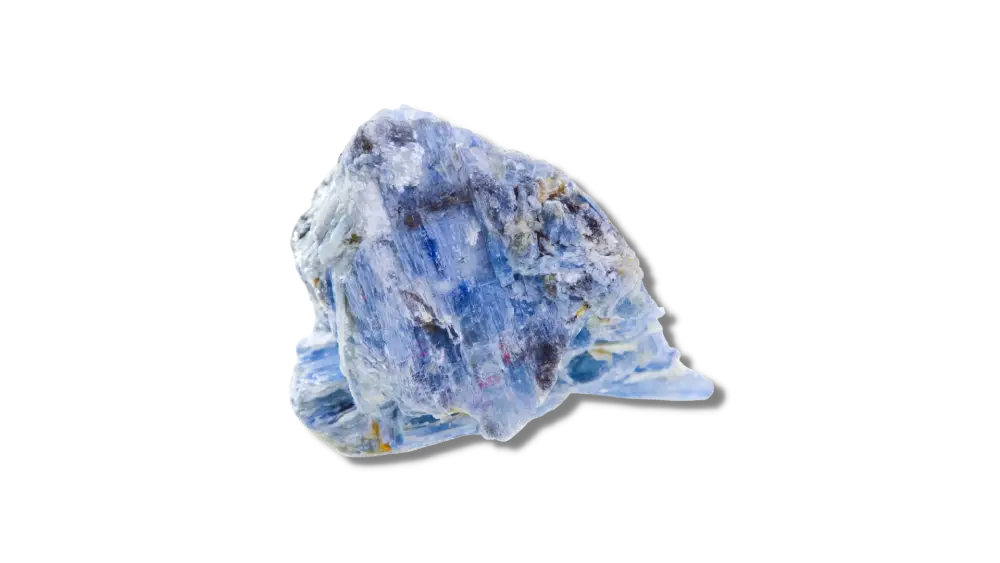
Kyanite Value
Kyanite is a gemstone but is not as valuable as other gems. However, because of its relatively low price point, Kyanite crystal makes an excellent stone to use as a gift or piece of jewelry for yourself or someone else.
The value of Kyanite depends on the size, color, quality, and cut of each stone.
Color: There are a lot of different factors that can impact the value of Kyanite, but the most important one is its color. Blue Kyanite is the most valuable variety. The more colorless and opaque the stone, the less valuable it is.
Size: Kyanite crystal comes in many colors and sizes. The size of your Kyanite will affect its price depending on how big the crystal is. If you have a massive piece of Kyanite that’s been cut into chunks of more than three inches, then expect to pay more per carat than someone who has smaller pieces that they’re selling individually or in sets (usually by the ounce).
Quality: Some Kyanite crystals have a better polish than others, affecting their value. For example, if yours has some imperfections on them, like cracks or lines running through them, your carat price will be much lower than if yours had no flaws!
Cut: When cut properly, Kyanite has beautiful patterns that resemble carbon fiber or fiberglass—these patterns are referred to as “ribbon” cuts because they resemble fabric ribbons.

Chakra Connection
Kyanite is a stone that’s connected to the third eye chakra. It provides clarity, insight, and perception. This stone is a stone of higher consciousness.
It is thought to help us to communicate with our spirit guides and angels, as well as the energies of the cosmos. It is said to be used for astral travel and meditation but can be used just as easily to improve communication with those around you.
It may help you focus inward, so you can meditate more efficiently and gain insight into your psyche. This is especially useful if you are trying to discover how to best express yourself or let go of old habits. Kyanite crystal is great for people who want to move through life with a sense of ease, confidence, and joy.
Kyanite is also the perfect crystal for the throat chakra. This means that it helps you speak your truth and encourages you to speak up for yourself. In addition, Kyanite crystal has a gentle energy that lends itself well to this chakra, where communication occurs.
Kyanite can allegedly help you to heal any relationship that has been damaged or harmed by lies or deceit. It will help you tell the truth about what has happened in your life and encourage you to be honest with others about who you are.
Metaphysical Properties
Kyanite is a beautiful blue-gray crystal that is found in several locations around the world. It has been used for centuries as an ornamental stone in jewelry and carvings and has essential metaphysical properties.
Some people use Kyanite for jewelry making as it does not negatively affect the body when worn next to it. In addition, it is said that wearing Kyanite will help to relieve stress and tension within the mind, allowing you to focus more clearly on the problems at hand.
Some believe this crystal can also help you eliminate depression by releasing negativity from your body through meditation or yoga sessions, allowing you to feel happier!
It is said that Kyanite increases energy flow through the body, making it helpful in healing injuries and ailments. It is also thought to break up blockages caused by negative emotions, helping you to move past old wounds and move forward with your life.
Kyanite may help you to develop patience and compassion when things don’t go your way. It’s an excellent stone for students or anyone who needs to focus on their studies or work.
It is believed that Kyanite can also help remove toxins from the body and cleanse the meridians (energy channels) to function more effectively. This could make Kyanite an excellent choice for those who suffer from chronic illness or pain management issues like fibromyalgia or arthritis.
Kyanite is a crystal of communication, truth, and integrity. It is considered an excellent stone for writers, speakers, teachers, and anyone who wishes to enhance their communication skills. Kyanite is said to align all chakras and aid with astral travel. Kyanite crystals can also be used to help you find your life purpose.
Kyanite Meaning and Uses
- Kyanite is a gemstone that is found all over the world. It has many different colors and can be used for jewelry (earrings, bracelets, pendants, etc.) and other decorative purposes because it has excellent durability and luster.
- Kyanite can also be used in industrial applications such as machine parts and bearings.
- Kyanite crystal is widely used in abrasives such as grinding wheels, sandpaper, and scouring powder.
- Due to its high thermal conductivity and durability, Kyanite performs well as a material used in heating elements. It also can resist heat which makes it ideal for use in high temperatures like those found in furnace components or kilns.
- It is used in ceramics. Ceramic artists love using Kyanite crystal because it has a high refractive index (meaning light bounces off of its surface well) and an iridescent quality that makes it easy to glaze over without losing color or texture when fired in kilns at high temperatures.
- It can be used to manufacture drill bits for mining operations.
- It can also be used to make jewelry, vases, bowls, sculptures, building materials (like tiles), windows, and other things that must resist high temperatures or be tough enough to withstand harsh conditions like extreme weather or chemicals.
- Kyanite can be used for cleansing purposes (such as clearing away negative energy from the environment), increasing creativity, and enhancing communication between people close to each other.
- It’s also a wonderful tool for meditation, as it helps you focus on what’s important and let go of things that no longer serve you.
- It is used to make refractory materials. Refractory materials are used in industrial processes that require high temperatures, like steel production and glass-making. Refractories are made by mixing Kyanite with other minerals such as quartz and feldspar. The mixture is then heated until the minerals fuse into a solid mass. The resulting material is hard and durable, making it perfect for high-temperature applications.
- Kyanite is sometimes used as an alternative to asbestos because it has similar properties but does not contain asbestos. This makes Kyanite a safer material for use in these industries.
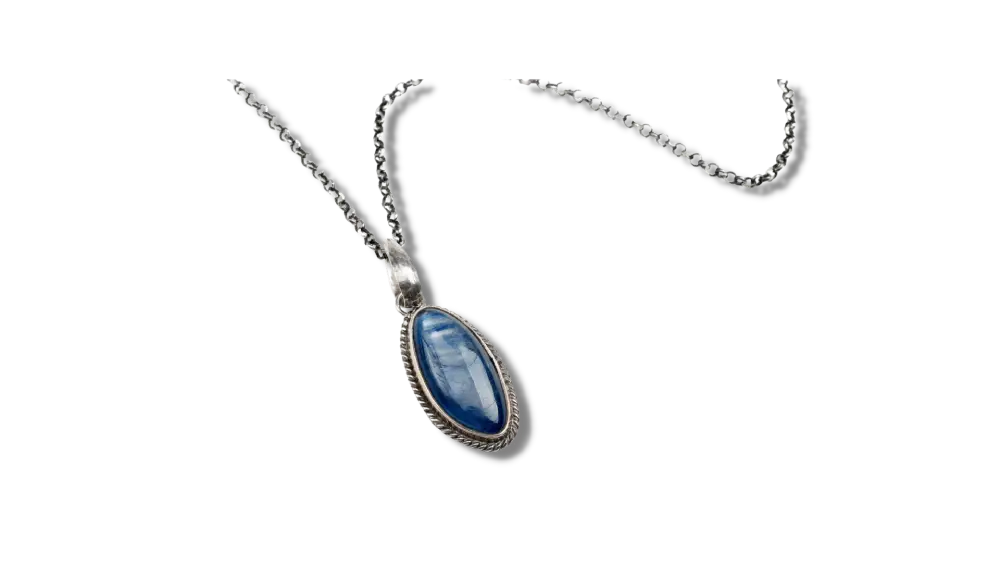
How to keep Kyanite Clean
Kyanite is a beautiful crystal that can be used for healing and communication. It can also be used in jewelry, but you’ll want to keep it clean so that it stays shiny and pretty. Here’s how:
- Wash your hands before handling the crystal.
- Fill a glass bowl with warm water and add one teaspoon of salt for every cup of water. Put the bowl on a towel, so it doesn’t move around while you’re working.
- Soak your stone in the solution for 15 minutes, then take it out and drain off excess liquid by gently squeezing the crystal between your fingers or palms (don’t use force!).
- Rinse under cool running water until all traces of salt are gone from the surface of the crystal, then gently pat dry with a soft cloth or paper towel
FAQs
Is Kyanite Rare?
Kyanite is a scarce mineral in the world. It is also a semi-precious stone, meaning that it is not quite as valuable as some other stones, but it is still quite beautiful and has a high price tag.
Is Kyanite heat treated?
Kyanite is not heat-treated. It is a naturally occurring mineral in many colors, including blues and greens. Therefore, Kyanite’s color can range from white to black, with most being some shade of blue or green.
What gemstones go well with Kyanite?
Kyanite goes well with other blue stones. Kyanite is a very cool, blue-gray stone often used in jewelry. It’s a great choice for anyone who wants to add color to their wardrobe or home decor, and it can look great with just about any type of gemstone.
Here are some other suggestions for how you can match Kyanite with other gems:
Aquamarine: This deep blue-green stone perfectly complements Kyanite’s cool tones.
Lapis Lazuli: This deep blue stone has been used for thousands of years in jewelry and architecture. It complements Kyanite’s cool tones beautifully!
Peridot: This bright yellow-green stone goes perfectly with Kyanite’s cool tones and makes for an eye-catching combination.
Amethyst: This violet quartz has been used in jewelry since ancient times—it pairs well with almost any color!
Is Kyanite a Sapphire?
No. Kyanite is not sapphire.
Kyanite is often confused with blue sapphire, a blue gemstone. But Kyanite is softer than sapphire and has a much lower refractive index—meaning that it doesn’t shine as brightly as sapphire does when light passes through it. So while they’re both beautiful gems, they’re not interchangeable.
Sapphires are corundum, which means they have a hexagonal crystal structure. Kyanite is made of aluminum and silicon but does not have the same crystalline structure as corundum.


